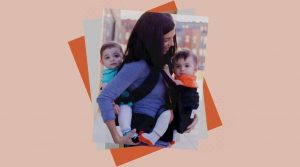Often when we think of wearing babies, we picture them against our chests in a sling or carrier, but carrying your child on your back is equally beneficial.
This is especially true in cases where a caregiver is beginning to experience back pain, is pregnant, or wants to wear two babies at the same time.
In this article:
Back carrying and baby age
It is important to remember that, at the end of the day, you know your baby better than anyone, and you should choose whichever line of reasoning makes you feel the most secure. With that said, there are two primary schools of thought about how old a child should be before riding in a back sling.
The newborn and up school of thought
Many experts believe your baby is perfectly safe being worn on your back as soon as they are born. They often point to other cultures, such as many of those in Africa, where mothers are very commonly seen going about their day with a happy baby securely wrapped on their backs. With that said, you cannot just use any old baby carrier for very young infants.
It is strongly recommended that parents use woven wraps to back carry their newborns. These wraps can be tightened in sections to provide maximum support while keeping your baby in the ideal position. There are also some mei teis crafted from wrap material that can lend similar flexibility and support to your child.
The four months and up school of thought
Some people advise waiting until babies are at least four months old before beginning to back carry, with a minority going so far as to recommend abstaining until children are one year of age. They argue that a parent will have a harder time routinely checking on their infant when he is on their back, as opposed to a frontward position where a baby can be continuously monitored with a simple downward glance.
While an agreement on the exact age wherein back wearing is safe varies among this school of thought, the general consensus is to wait until an infant has good neck and head control before shifting them into a back carry.
Developmental issues and babywearing
It is essential to factor in your baby’s individual needs before making the switch from front carrying to back carrying. Some babies may have been born with a disability that makes it harder for them to maintain a clear airway or have other special needs that demand more vigilant monitoring than back carrying can allow.
If you have any concerns, remember that your pediatrician is an excellent resource to check in with as you strive to do best for your baby’s health.
Related: Baby K’tan Breeze vs Active (2021 Comparison Guide)
Positioning your baby for a back carry
Once you have decided to join the baby back wearers of the world, you’re probably turning your thoughts towards how they should look in their back sling. You want your baby to have
- A gently curved spine.
- Knees that are slightly parted.
- A supported neck.
- No fabric obstructing their mouth and nose
Getting your baby in a back sling
Arguably, the most daunting thing about back carrying is actually saddling up your kiddo safely and appropriately. I’m not going to lie; it can be a little tricky at first, and I encourage you to practice with a doll to get your technique down.
The best way to learn is by watching and doing. If you do not have a fellow baby wearer in your life who can pass along their knowledge, the internet is full of tutorial videos with step by step instructions.
South East Slings provides great step-by-step videos on their youtube channel, including this secure high back carry and Liliputi Wraps has an easy to follow rucksack wrap video.
Both of these techniques are great for maintaining the ideal body positioning to keep your little one secure and comfy. They also allow you to orient your baby higher on your back, making it easier to check in with him and providing him with a great view of his surroundings.
Safety considerations
Regardless of when you decide to start back carrying, there are a few key things to remember to keep your kiddo protected.
- Be sure you are familiar with your sling before you put your child in.
- Pay attention to weight and age limits before purchasing a sling.
- Always bend at the knees, never at the waist.
- Practice putting your baby on your back with another person in the room to serve as a spotter.
- Stand over a soft surface when putting your child in the sling until you are well-practiced.
- Inspect your sling for wear and tear before each use.
- Launder your sling regularly.
- Check your baby frequently when they are riding on your back, paying particular attention to their breathing, their temperature, etc…
Benefits of back carrying for your baby
If you are still tempted to forgo wearing your baby on your back in favor of using a stroller, it’s worth remembering that close contact with your child will not only be a source of comfort but will also promote their development. Babies who are carried often
- Cry less.
- Have improved sleep habits.
- Experience a level of bonding and safety that can lead to greater confidence as they grow.
- Have improved head and neck control.
- Experience fewer hip problems as they grow.
- Can better develop social and language skills.
- Have more regulated temperature, heart, and breathing rates.
- Are less susceptible to developing a flat area on the back of their head.
Related: Babywearing: 23 Science-Backed Benefits
Benefits of back carrying for you
But it’s not just you mamas that benefit from babywearing. All caregivers will
- Enjoy an increased level of bonding with their infant.
- Keep their hands free without sacrificing cuddle time.
- Be able to keep a closer eye on their baby while still accomplishing their daily chores and errands.
- Experience reduced lower back pain with back carries.
FAQs
How can I keep an eye on my baby while back carrying?
A simple handheld mirror is a great way to glance over your shoulder without straining your neck into a horror movie position. Similarly, if you’re walking on the street next to reflective windows, it is easy to do a little spying on what your little one is up to.
By carrying in a high-back position, you will be able to feel your baby’s breath against your neck, making it possible to closely monitor your baby’s breathing.
Can I use soft structured carriers to back carry my newborn?
These types of carriers are designed with older children in mind and generally not appropriate for very young babies. They do not mold to your infant’s body, making it easier for a newborn to slump down and end up with a compromised airway. Soft structured carriers also tend to sit lower on the back, which can make monitoring very young babies harder than if they are positioned higher.
With that said, soft structure carriers are not bad, they’re just not the most appropriate way to back carry a young infant. Once your little one has good control over his neck and torso muscles, including the ability to hold his head up for extended periods and sit up on his own, these carriers can be a great addition to your baby gear stash.
Related: Solly Baby vs Happy Baby Wrap (2021 Comparison Guide)
Is it unsafe to carry my baby lower on my back?
Provided your baby is correctly secured in an appropriate sling and is positioned so that his airway remains open, a lower back position is fine. In fact, many parents, especially men, find that it’s more comfortable since it puts a bit less strain on back muscles.1SAFETY WHEN CARRYING: BUSTING SOME MYTHS
The big concern with a lower-back carry is that it is harder to glance over your shoulder for a quick baby check, and you cannot feel them breathing against your neck. If you decide to carry your baby lower on your back, remember to be extra vigilant about checking in with him.
Where can I find in-person help to learn how to do a proper wrap?
If you’re having a hard time mastering a safe wrap technique, all the written instructions and YouTube videos in the world might start to look and sound like they’re in Latin.
Luckily, many areas have in-person support groups. The babywearing advocacy site, Wrap Your Baby, has an extensive list of support groups that meet all around the world. You can search for a gathering near you by clicking here.
If you are unable to locate local help, talk to your doctor to see if he or she is aware of any programs that will assist you. You can even start a group of your own and meet some new mama friends!
Conclusion
Traditionally in the West, back carrying is deferred to around 4-months or so, when baby has greater control of their head and neck – it certainly makes breastfeeding in public much more manageable and that little head is always within kissing distance. That said, this isn’t a hard and fast rule, and back carrying can happen safely from almost any age. However, it is recommended that you seek professional support if you intend to back carry a young infant. There is a lot of technique you need to get right to ensure your baby’s safety, and not all slings or carriers are suitable.
As Dr Rosie Knowles, the UK’s top baby carrying expert puts it:
“I really do recommend seeing a professional to get some help and teaching if you are planning to back wrap a young baby, as there is a lot to get right. For example, the correct tension to support neck and airway for safe breathing, getting it snug all round to avoid baby slumping to one side or slipping down inside, and getting the right amounts of slack out at various points to ensure there isn’t too much tightness around the neck and the knees which can leave red marks. 2Beginning to back carry
So, if you are highly experienced or planning to receive professional training, then any age can be suitable for back carrying, but otherwise, it’s best to wait until your baby has control of their head and neck at around 4-months.








